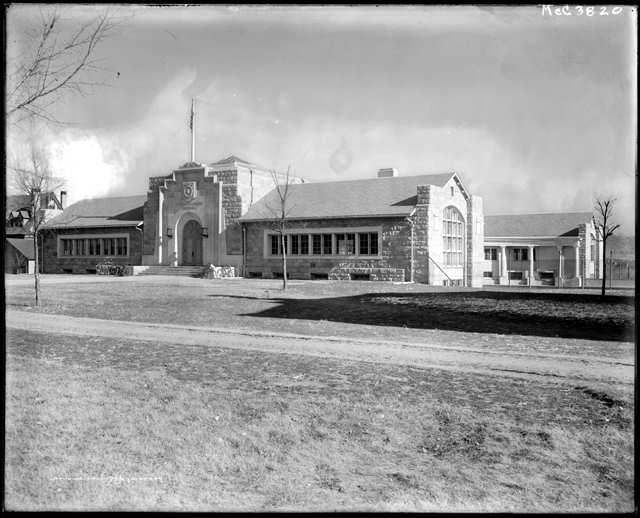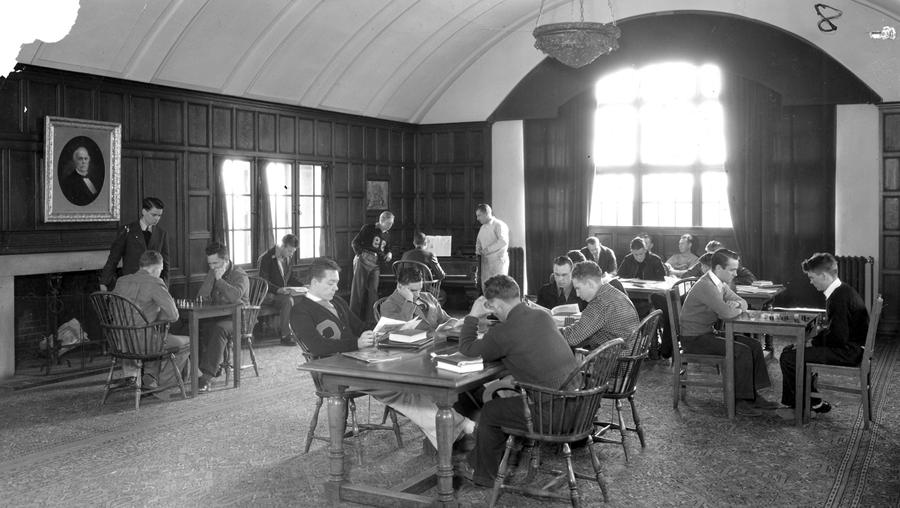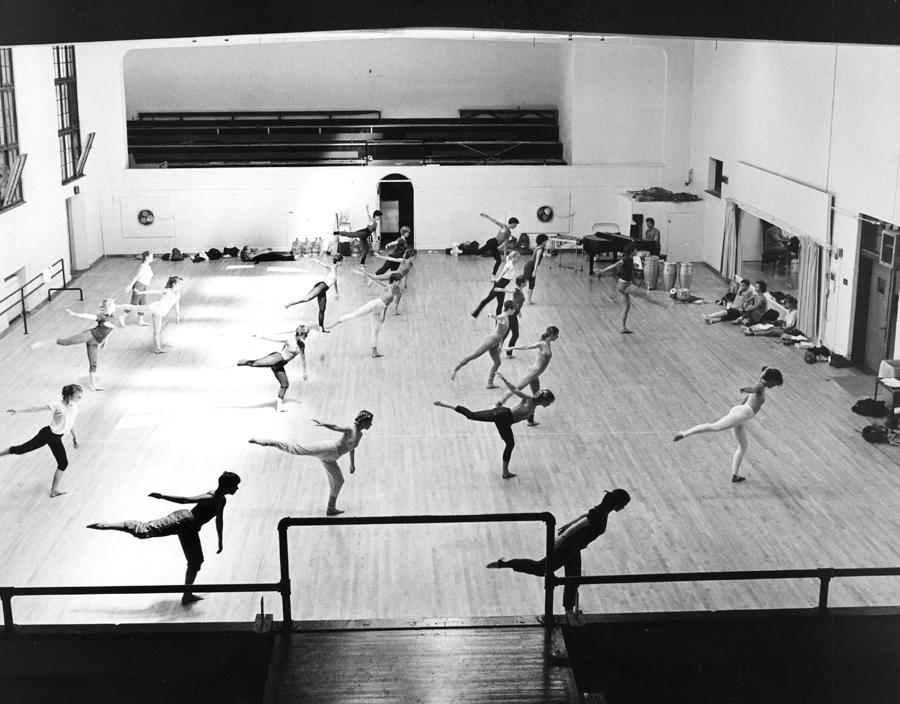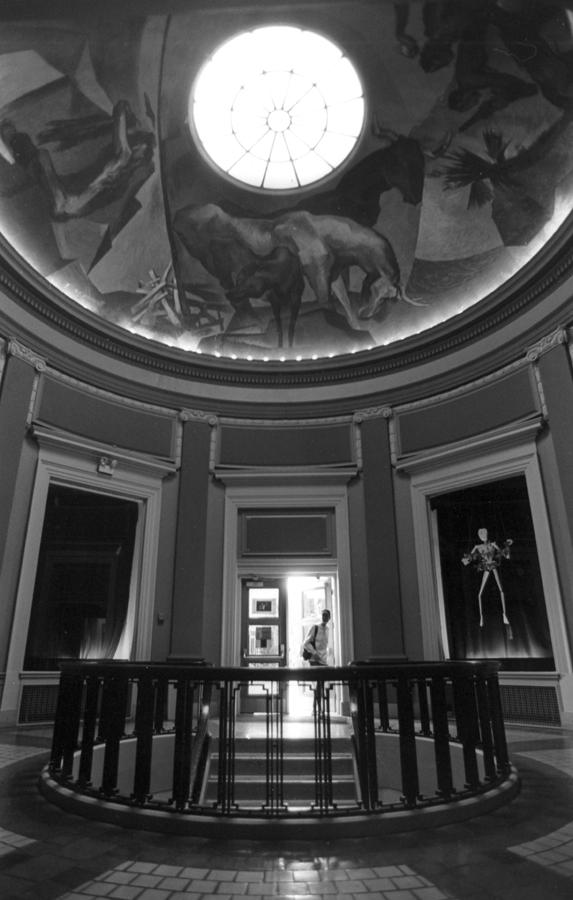Cossitt Hall
Tour Stop: #2
Current Name: Cossitt Hall
Historic Name: Frederick H. Cossitt Memorial Hall
Address: 906 N. Cascade Avenue
Year Completed: 1914
Architectural Style: Neoclassical and Art Moderne
Architect: Maurice B. Biscoe, Denver
Designation: National Register
Access Level: Cossitt Hall is a working building. The public is invited inside, but we ask that ongoing activities not be disturbed.
Historic Preservation Alliance Award
2009年,赌博正规的十大网站获得了科罗拉多斯普林斯历史保护联盟颁发的优胜奖,以表彰其修复弗雷德里克·H. Cossitt Memorial Hall. 该奖项特别引用了906 N的Cossitt Hall的“历史兼容的民事修复”. Cascade Ave.
The Cossitt Hall renovation was a challenge because the building is in near-constant use. Renovation priorities included keeping the historic architecture intact while improving the building's energy efficiency; increasing accessibility; and making effective use of the building's interior spaces.
Cossitt Hall today houses the classics and comparative literature departments, a lounge, three new dance studio/classrooms, offices for dance professors, new locker rooms, practice areas and green rooms for the dance program.
The 1914 Frederick H. 科斯特纪念堂满足了长期以来对建筑的需求,为学院的男学生提供运动和社交设施. The building's eclectic design contains Neoclassical and Modernistic elements, 而它的材料结合了在学院的几座主要历史建筑上发现的城堡岩流纹岩和许多后来的校园建筑中使用的混凝土构件. Completion of Cossitt ended the period of major development during William F. Slocum's presidency, which saw greatly expanded and improved campus facilities, recruitment of a distinguished faculty, growth of the student body, and recognition of the college's national reputation. Cossitt was the last building erected on campus until Shove Chapel in 1931.
After completion of necessary academic and residential buildings, interest in providing adequate athletic facilities at the college grew rapidly. In 1891, 一个简单的框架结构由学生付费,竖立在哈格曼大厅以西,供男学生和大学运动队使用. Women gained their first access to physical education facilities in 1903, when McGregor Hall opened with a small gymnasium in the basement.
By 1909, 支持建设男子多功能体育馆的呼声在大学社区中高涨起来. The Tiger student newspaper editorialized about the specter of "grinds,“那些只专注于学业而忽视体育锻炼的学生很早就去世了. 校园集会支持修建一座建筑,运动员可以在这里训练,支持者可以在这里进行助威和打气活动.
Students staged drives to marshal support for such a building, 但竞选活动依靠斯洛克姆总统的筹款能力筹集了所需的大部分资金. Slocum persuaded a distant New York cousin, Helen Cossitt Julliard, a resident of New York, to donate the entire $113,000, with the provision that previously-raised funds would go to other campus projects. Mrs. Julliard, whose husband's family had ties to the Julliard School of Music, asked that the building be named after her late father, Frederick H. Cossitt, who had been prominent in New York real estate, insurance, and banking.
The college selected Denver architect Maurice B. Biscoe, who had prepared plans for 1908 Bemis Hall, to design the building. Biscoe moved to Denver from Boston in 1905 to oversee the construction of Denver's St. John's Cathedral and subsequently opened his own office there, working on such commissions as the Dickinson Branch Library and Clayton School for Boys, as well as buildings at the Myron Stratton Home in Colorado Springs. In 1920, the architect returned to Boston and joined the firm of Andrews, Rantoul and Jones, the successor to Andrews, Jacques and Rantoul, which had designed 1904 Palmer Hall at Colorado College.
At the groundbreaking for Cossitt Hall in April 1913, President Slocum emphasized the importance of athletics in the college curriculum:
科学的体育训练应该成为每个人教育的一部分, just as much a part as his mathematics, English, or philosophy. One is just as important as the other, and therefore should have just as much recognition in college standing and credit . . . . This building has just as sacred a mission as a church, a lecture hall or a library.
Cossitt Hall, dedicated in June 1914, included a basketball court, training rooms, locker facilities, and shower rooms. 有观众座位的新体育馆的出现激发了校园里对篮球的兴趣, 从1922年开始,大学队连续四年赢得落基山会议冠军. 从建筑南端突出的椭圆形体育场(“cossit Bowl”)以分层座位为特色,并被用作室外跑道, playing field, site for pep rallies, and theater. Cossitt Hall also functioned as a social center or men's club, with a 200-person capacity dining room, a kitchen, a common room for informal gatherings and reading, and a large room for student meetings. A pool table was located in the basement. 该学院采用了三年的体育课程要求,在设施完工后毕业.
After Cossitt opened, all men students, including those living in fraternity houses, were required to take their meals in the new hall. 《全球十大赌博靠谱平台》(Colorado Springs Gazette)将这座建筑视为学生生活中的一个民主化因素,因为所有阶层和阶级的人都聚集在休息室共进晚餐和参加社交活动. The Middle-West School Review favorably profiled the building in 1915 and observed:
因此,在科斯特纪念馆进行的工作在许多方面触及了学生的生活. . . . New men gather about the piano to learn the college songs, and old and new meet to practice college cheers, 因此,获得了共同的接触和观点,这对创造所谓的微妙的“大学精神”有很大的帮助.'
The college initially prohibited smoking and playing cards in the Cossitt lounge, prompting students to stage the first organized protest in the history of the campus. A board created for governance of the hall, composed of faculty, alumni, and students, quickly overturned the rule.
This Building
in History:
When President E. P. Tenney took over the inchoate Colorado College in 1876 (the summer of Custer's Last Stand, of the Nation's Centennial and of Colorado's statehood), his first educational move was to hire W. D. Sheldon and send him to Colorado Springs to begin instruction in classics.
Over the years Cossitt Hall housed a variety of activities. During World War I in 1918, 500多名男子被分配到该学院的陆军信号部队学校,他们住在体育馆,在科斯特餐厅用餐. The Julliard Room at Cossitt Hall became the meeting place for the college's C Club. 该组织成立于1919年,汇集了对体育运动感兴趣并有成就的男性. As early as 1914, the senior class staged Euripides' "Electra" in Cossitt Bowl during commencement, and in the 1920s and 1930s several plays were presented there by the Classics Club.
In 1941, 赌博正规的十大网站校长瑟斯顿·戴维斯邀请舞蹈艺术家汉雅·霍尔姆到校园领导一所暑期舞蹈学校. 霍尔姆花了43个夏天进行为期8周的舞蹈课程,主要在科斯特体育馆授课. 以前的学生克劳迪娅·吉特曼(Claudia Gitelman)回忆说,地板“有一种醇厚的光泽,正好适合舞者的光脚。. High windows let in the light needed in daytime." Holm, a native of Germany, studied under Mary Wigman before coming to America in 1931. 她成为了一名著名的舞蹈艺术家,在创办汉雅·霍尔姆-赌博正规的十大网站暑期舞蹈学校之前,她是本宁顿学院暑期舞蹈学校的四位主要教师之一. In the 1950s and 1960s, she developed choreography for "Kiss Me Kate," "My Fair Lady," and "Camelot" on Broadway. At the peak of Holm's summer dance school in the 1960s and 1970s, the tuition generated by her classes reportedly "carried" the rest of the summer program. During the 1965 summer session, 许多以前的学生在舞蹈方面取得了突出的成绩,他们回来用为期一周的一系列表演来纪念霍尔姆. In 1983, citing declining enrollment and other factors, the college abruptly terminated Holm's association with the institution, a decision widely regretted in the dance world.
In 1948, artist Eric Bransby painted a mural in the entrance rotunda of Cossitt. "Settlement of the West" depicts goldseekers, migrating settlers, the cattle industry, and trappers and traders. Born in Albany, New York, in 1916, Bransby studied at Colorado College and taught at Yale University, the University of Illinois, Western Illinois University, and the University of Missouri. 科罗拉多斯普林斯地区其他有布兰斯比壁画的地方包括科罗拉多斯普林斯医疗中心, U.S. Air Force Academy Planetarium (later installed at the Colorado Springs Municipal Airport), Air Defense Command Headquarters, and the Colorado Springs Pioneer Museum. 2002年,80多岁的布兰斯比回到科西特的圆形大厅修复他的壁画.
20世纪50年代中期,在贝米斯大厅的泰勒餐厅完工后,Cossitt的餐厅关闭了. 1957年,cositt Bowl被拆除,1963年,Honnen Ice Arena占据了部分场地. 直到1970年,科斯特大厅一直是大学体育项目的中心, when the El Pomar Sports Center was constructed. Cossitt Hall briefly became a center for women's athletics. Today, 该楼设有戏剧与舞蹈系、古典与比较文学系. 1997年,科斯特大厅因其历史和建筑意义而被列入国家史迹名录.












